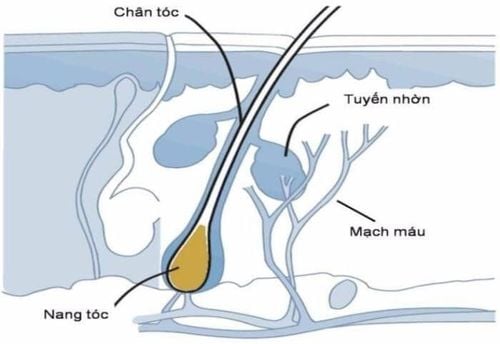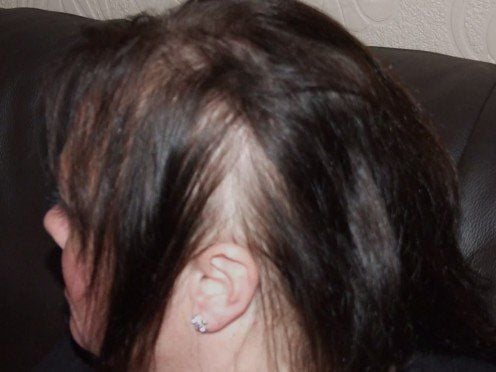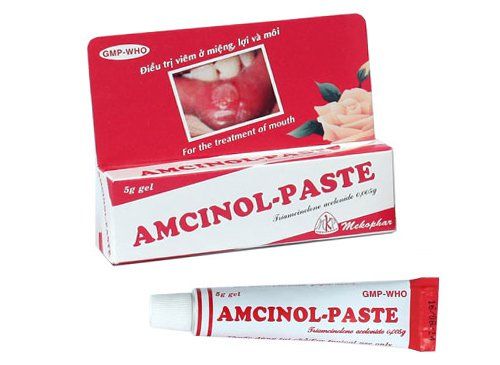This is an automatically translated article.
Normally, hair follicles are responsible for hair growth, which happens in a cycle consisting of three different phases. These follicles also determine your hair type, such as straight or curly. Once damaged, the hair follicles can stop producing hair and cause the hair growth cycle to slow down.
1. Anatomy of the hair follicle
A hair follicle is a sac-shaped structure located in the epidermis (outermost layer) of the skin. According to the American Academy of Dermatology, humans will have an average of 100,000 hair follicles on their scalp. Hair will begin to grow at the bottom of the hair follicle. The root of the hair is made up of protein cells and is nourished by nearby blood vessels.
As more cells are produced, the hair will protrude from the skin and reach beyond the surface of the scalp. Meanwhile, the sebaceous glands near the hair follicles will keep the function of producing oil, helping to keep hair and skin healthy and full of moisture needed for growth.
2. Hair growth cycle
Normally, hair will grow out of the hair follicle and grow in a certain cycle. A hair growth cycle will go through 3 different stages, including:
Anagen (growth) phase: hair begins to grow from the root. This stage usually lasts three to seven years.
Catagen (transitional) phase: hair growth begins to show signs of slowing down, and hair follicles also shrink during this phase. Typically, Catagen will last two to four months.
Telogen (resting) phase: old hairs fall out and are replaced by new hairs that begin to grow from the same hair follicle. This usually lasts three to four months.

Chu kỳ sinh trưởng của tóc
In addition, each different hair follicle will go through different stages of the same growth cycle. Some cysts may be in the growing phase, while others may be in the resting stage. Or some hairs are in the growing phase, while others are falling out.
According to researchers, an average person will lose about 100 hairs per day. And yet, about 90% of your hair follicles are probably in the Anagen phase at any given time.
3. The role of hair follicles
On average, your hair will grow out about half an inch per month. Overall, your hair growth rate can be influenced more or less by your age, hair type, and overall health.
Hair follicles are not only responsible for the rate of hair growth, but they also significantly affect the appearance of the hair. The shape of the hair follicle will determine the degree of curl of the hair. Round follicles will produce straight hair, while oval follicles will produce curly hair.
Besides, hair follicles also play a part in determining a person's hair color. Similar to skin, our hair is also pigmented due to the presence of melanin. For human hair color is usually determined by two main types of melanin, including eumelanin and pheomelanin.
Through genes will help determine whether you have eumelanin or pheomelanin, as well as the amount of pigment you have. Abundant amount of eumelanin makes hair black, a moderate amount of eumelanin will make hair brown. If there is little eumelanin in the hair follicles, your hair will be yellow. On the other hand, the pigment pheomelanin will give the hair its red color.
Thus, both these melanins are stored in the hair follicle cells, which then determine the color of the hair. At some point, the hair follicles can lose their ability to produce the pigment melanin (especially in older people), leading to the growth of gray or white hair.
If hair is popped out of the hair follicle, they can grow back. However, when hair follicles are damaged, hair production stops. Certain conditions, such as alopecia areata, can cause hair follicles to stop producing hair altogether.

Hình ảnh vị trí của nang tóc
4. Some problems related to hair follicles
Some hair conditions can stem from problems related to hair follicles. If you are suffering from any of the following situations, or have unexplained symptoms (such as hair loss), it is best to consult a dermatologist.
Hair loss: Androgenetic hair loss, also known as male pattern baldness. This is a condition that greatly affects the growth cycle of the hair follicles on the scalp. With this condition, the hair growth cycle slows down and weakens, eventually stopping altogether. This will prevent the hair follicles from producing any new hair. According to statistics from the US National Library of Medicine, about 50 million men and 30 million women are affected by male hormone hair loss.
Alopecia areata : this is an autoimmune disease. That is, the immune system mistakes the hair follicles for foreign cells and attacks them, causing the hair to fall out in patches. It can even lead to total body hair loss, which means hair and hair all over the body is lost. There is currently no cure for alopecia areata, but steroid injections or topical treatments can slow down your hair loss somewhat.
Folliculitis: is a condition in which the hair follicles become infected. It can occur anywhere hair or body hair grows, including:
Scalp Face Underarms Arms Legs Folliculitis often looks like a rash with small bumps appearing on on the skin. The bumps can be red, white, or yellow, and sometimes contain pus. Often when having folliculitis, the patient will feel very itchy and painful.
The main cause of folliculitis is usually a staph infection. However, this disease can go away on its own without treatment, but your doctor will still diagnose and prescribe medication to help you control it. This may include topical therapy or the use of oral medications to treat the root cause of the infection and ease the symptoms of folliculitis.
TE (telogen effluvium) alopecia: this is a temporary and highly common form of hair loss. A stressful event can also cause hair follicles to enter the Telogen phase prematurely, leading to thinning and loss of hair.
For TE alopecia, the hair usually falls out in patches on the scalp. However, in some severe cases, they can fall out in other parts of the body, including the legs, eyebrows, and pubic area.
The stress that causes TE hair loss can stem from:
A traumatic physical event Childbirth Use of a new medication Sickness Surgery A stressful life change A shock can trigger activates a change in the hair growth cycle. TE hair loss is temporary and does not require treatment. However, you should still discuss specifically with a dermatologist so that other causes can be ruled out.

Hình ảnh bệnh nhân rụng tóc kiểu TE (telogen effluvium)
5. Will hair regrow after shedding?
When suffering from diseases such as hair loss or baldness, can we stimulate the hair follicles to regrow hair?
In fact, if a hair follicle is damaged, you won't be able to reactivate it. Now researchers have found a new way to reactivate dead or damaged hair follicles. However, this treatment has not yet been tested in humans and has not been approved by the Food and Drug Administration (FDA).
Please dial HOTLINE for more information or register for an appointment HERE. Download MyVinmec app to make appointments faster and to manage your bookings easily.
Reference source: healthline.com












